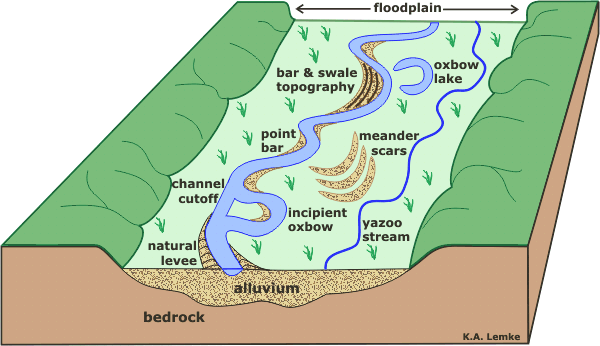There are three major kinds of processes that happen in a river. Streams can be put in groups arranged by it; for example, when the index is in between 1 as well as 1.5 the river is sinuous, but if between 1.5 and also 4, then meandering. The index might call for elaboration, because the valley might twist too– i.e., the downvalley length is not identical to the reach. The technological summary of a winding watercourse is labelled meander geometry or meander planform geometry. Ideal waveforms, such as a sine wave, are one line thick, however in the case of a stream the width should be taken into consideration. The bankfull width is the width the bed at an ordinary cross-section at the full-stream level, typically estimated by the line of least expensive vegetation.
Clearly, the erosion brought on by moving water is the system; centrifugal pressure produces much faster water outside of a bend. Among the most distinguishing characteristics of the river in the center course is its enhanced sinuousity. Unlike the reasonably straight channel of the top program, in the center course there are numerous twists in the river. Meanders enhance themselves– the stream often tends to erode outside of the meander as well as deposit sediment on the within. At some point, the meander will certainly circulate up until now from the stream’s mean path that the stream crosses it. Eventually, the old meander will certainly become an oxbow lake and fill in.
Not The Response You’re Trying To Find? Surf Other Inquiries Marked Hydrology Rivers Potamology Or Ask Your Own Inquiry
This is due to the fact that the depth of the water on the outside of the bend is deeper, so there is less friction as well as therefore higher velocities. Notice the deposition on the within the meanders and the river high cliffs or bluffs on the outside of the meanders. Why does the river wear down side to side to the ideal side then the left side? Surely it would certainly erode both sides at the same time and as a result the river would certainly enter a straight line.
- The higher the curvature of the bend, as well as the quicker the circulation, the more powerful is the cross-current and the sweeping.
- Meanders intensify themselves– the stream tends to erode on the outside of the meander and deposit sediment on the inside.
On the opposite side of the channel where the velocity is reduced product is transferred. The picture listed below shows proof of undercutting on the outer financial institution as well as deposition on the internal bank of the meander. They are located on the outside of a stream bend, opposite theslip-off slopeon the inside of the bend. Their form is similar to a smallcliff, and are developed by the erosion of dirt as the stream collides with the river financial institution. Instead of apoint bar, which is a location ofdeposition, a cut bank is a location oferosion.
Meander
Meanders are regular landforms at the center and also reduced courses of a river. Twist slopes are usually a lot more gentle and they experience side erosions which widen the channel of the river at the center and also reduced programs of a river. Normally, the energy going along with circulation water in a river decreases progressively from the top training course of the river to the most affordable program of the river.
After an extended period of time, the meander becomes very rounded, as well as at some point the neck of the meander ends up being narrower and the river cuts through the neck throughout a flooding, removing the meander as well as creating an oxbow lake. Where the river swings in the direction of the financial institution disintegration triggers damaging. Meanders are the result of both erosional and also depositional processes.
Twist Geometry
Thus, early use of the term, from the late 1500s, described convoluted as well as windy speech and also concepts, as well as the geomorphological attribute. The river in Turkey is called Menderes River, south of Izmir, near the ancient Greek town of Miletos. After numerous floodings there are several layers of debris deep on the flooding plain. The location over which they flooding is called the floodplain and this usually accompanies regions where twists kind. Within the river itself, thefastest current is discovered outside of a bend as well as the slowest current on the within the bend, this can be observed on diagram A.
If there is a flooding plain, it extends past the meander belt. The meander is then claimed to be complimentary– it can be found anywhere in the flooding plain. At any kind of cross-section the circulation is adhering to the sinuous axis, the centerline of the bed. 2 consecutive going across points of sinuous and down-valley axes specify a meander loop. The meander is two successive loopholes directing in contrary transverse directions.
Where Is A River Fastest?
The thalweg hugs the external financial institutions and go back to center over the riffles. The meander arc length is the range along the thalweg over one meander. Disintegration, transport as well as deposition are all procedures that create the particular features of twists displayed in the pictures above. There are several stages involved in the development of twists. The meander pattern is common; it’s difficult to locate examples of straight streams of fantastic length and also, even then, the undersurface of the channel– the thalweg– will twist within the straight network.
They are typical of the middle and lower course of a river. This is because upright disintegration is replaced by a sideways form of erosion called LATERAL disintegration, plus deposition within the floodplain. The meander ratio or sinuosity index is a way of evaluating how much a river or stream meanders. It is determined as the size of the stream divided by the size of the valley.